
Move Right Instead Of Left



I used the word “tradition” voluntarily here. What is a tradition? Google says, “the transmission of customs or beliefs from generation to generation, or the fact of being passed on in this way.” What he did was to share the Bujinkan spirit with his older students (October 1997 and February 2015).
At lunch, he would take the temperature of the Bujinkan, and speak about the Bujinkan. I have good memories of those moments.
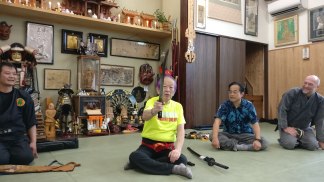
But in the recent Sundays, Sensei moved from “tradition” to history. He often speaks now about the old Jidai. (1) With better knowledge about history, he wants us to prepare the future Jidai of the Bujinkan. (2)
He wants us to understand the symbol of Samurai warfare, the sword.
Last Sunday, he arrived from his usual sword dealer with six new swords and detailed them to us. He said, “high ranks must understand the Japanese sword. This is the key to unlock the understanding of Mutō Dori.”
 History is significant when you train martial arts, this is not a sport. Japanese history is about survival, and these weapons made it possible.
History is significant when you train martial arts, this is not a sport. Japanese history is about survival, and these weapons made it possible.
By understanding the weapons, you get a glimpse on how you can move with them and survive in battle. And he wants the Dai Shihan to get this.
History comes from the Greek ἱστορία – historia, meaning “inquiry, knowledge acquired by investigation.” It is Rekishi in Japanese. History is the discovery, collection, organization, and presentation of information about past events. (3)
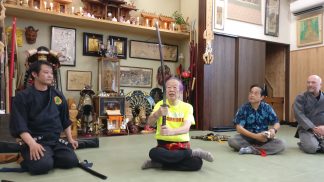 We have to study Rekishi should and investigate it seriously. That is if you want to get the knowledge of the Samurai.
We have to study Rekishi should and investigate it seriously. That is if you want to get the knowledge of the Samurai.
Our Waza were created during the Sengoku Jidai, (4) -what historians call the “Age of Warring States.” This period began with the Ōnin wars (1467-1477) and lasted for about a century. (5)
Oda Nobunaga emerged from this time of chaos and began the unification of the country. It will end with Hideyoshi, and bring Japan to peace with Tokugawa. This extended period of five centuries is the Bujinkan Jidai!
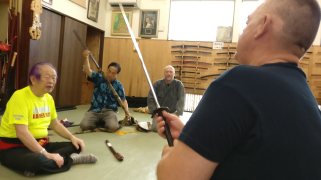 The history of the Samurai is what makes Japan so different from our own history. Initiated by Minamoto no Yoritomo with the Genpei War (fall of the Taira in 1185), a new Japan is born. (6)
The history of the Samurai is what makes Japan so different from our own history. Initiated by Minamoto no Yoritomo with the Genpei War (fall of the Taira in 1185), a new Japan is born. (6)
The victory of Tokugawa at Sekigahara in 1600 completes the transformation. (7)
Our fighting arts are the means with which these changes were carried out on the battlefield.
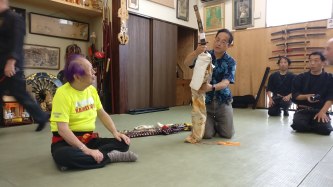
Ignoring Rekishi is limiting the Bujinkan to another sport martial arts.
Thus the reason why Sensei wants us to study it.
The dōjō logic replaces the military needs with a form of business at the beginning of the 17th century. It is very far from the Yoroi logic developed on the battlefield.
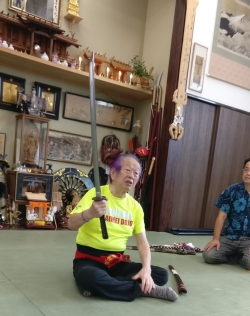
This is during this period that the Katana (Edo) replaces the Tachi (Sengoku). As a consequence, Tameshi Giri will develop only after the Samurai stopped fighting. (8)
This is the knowledge Sensei wants us to get.
One thing Sensei said on Sunday, was that “you should know what weapon is good for you.” Study them and use the ones that fit your abilities.
The Bujinkan Rekishikan (9) covers the 12th to the 17th century.
It should be studied like any other Waza.
Rekishikan can lead to Reishikikan, and give us “the intuition to have the correct manners of a knight.” (10)

These days Hatsumi Sensei arrives late and leaves late. It is not rare these days to finish three hours after the beginning. And Sensei explains a lot in class and during the breaks.
Sunday was no different. And Sensei is full of projects. He is getting a hundred Ninjatō swords to make an exposition. He wants to show the public how wrong scholars are about Ninpō. He is also preparing a new book with Kodansha on swords.
During class, a group of more than seventy were present. Sōke said that Dai Shihan should now train with a metal sword to understand the type of control of Mutō Dori. In the movements, he then detailed more of his understanding of “control.” Control is an essential part of Mutō Dori, but I guess that by now, you have figured it out.
Like in the previous sessions we did each technique with taijutsu, knife, hanbō, biken, and bō.
One concept he developed is “Muishiki,” unconsciousness. (1) This is the mental state where Mutō Dori can express itself. There are no more waza, no techniques.
What he does is beyond that. This also makes it very hard to explain with words. This is why in this post, I will use the words he said during training. Every quote will help you understand what “control is. It is not simple, except when he does it.
“Come close and stick to him.”
As always distance is a crucial element to master control. As there is no technique, what Sensei does is pure taijutsu. When you are afraid of the attacker, he feels it and continues even more to attack. By using “Yokeru Janai” (don’t avoid) and “Tatakai wa Janai” (don’t fight) (2), you stay close to the attacker and stick to him. This closeness forces him to react and stops his actions. Each Uke Sensei used stopped their attack after one movement. As we said earlier, they looked like suspended in mid-air. (3)
“Uke must not know what is happening, it is essential.”
Uke stops because what he faces is not logical. As Sōke is Muishiki, there is no intention he can detect. At the same time, there is no waza. Uke stops because there is no fight. He stays there because he doesn’t know what is happening. All senses are out.
“You’re not attacking or hurting him, you’re controlling.”
The quality of the control makes this lack of feeling possible. You don’t fight Uke, you position your body out of his reach but keeping contact with him. There is no fight, only control.
“Amo Isshun no Tamamushi.” (4) (5)
Ae you don’t use or show any force, Uke is not willing to attack. Sensei used the image of Amo Isshun no Tamamushi. The bee trapped between your hands will not sting because it is blind. It is unaware of what is happening.
“Remember to control within the space. Use the space within.”
Because Uke doesn’t feel, he is not threatened. You keep him controlled within the space. (6)
Muishiki is part of all that. It is like some Buddhist techniques of active meditation. You are free to move and to do whatever is possible. In Mutō Dori you are in control of yourself, of your opponent, and of your environment.
Muishiki. You are one with the universe.
_____________________

After trying my best for many years, I have come to the conclusion that I have to quit training. At least, this is the feeling that everyone must have had today during Senō sensei’s class.
Today only fourteen came to the Honbu to train. I found it strange. Friday night, more than seventy participants attended Sensei’s class. I guess the light morning rain is to blame.
Only black belts were training, and a majority of us were fifteenth dan. Everyone was lost. And I guess that many were wondering what they were doing there. No one in the room could reproduce the two techniques of Senō sensei today!
Many like me must have thought: “Ok, this is too much, I quit the Bujinkan!”
And the techniques were simple: Omote Gyaku (taijutsu); and Tsuke Iri (hanbō). Finding something more fundamental is hard. But in Senō sensei’s personal blender, they become impossible.
We could have done them as we usually do them, but then why bothering to attend a masterclass? The others might have thought that. Who needs to get out of the comfort zone? And it was raining, you know?
Even though I couldn’t do them the way he demonstrated them, I will give you here a few glimpses of what he did.
Omote Gyaku:
On a right Tsuki. You absorb the fist with the right hand in a “U” shape. Your legs are on the same line once you have the perfect distance.
You side-step to the left, and your body gives the attacking hand to your left hand. The right elbow stays close to the body. Power comes from the legs, not the arms.
It is essential to keep a certain distance between Uke and you. If you get too close, he will attack with the other fist.
Your body is now on the right side of Uke, your feet in Shizen.
You hook Uke’s thumb with yours while your forefinger creates a Shiten on the wrist/forearm (see picture). There is no force.
Then using the other fingers as if playing the piano you turn the soft grip from the right hand to the left. The “piano” movement happens at the same time you move your left leg forward.
His hand is now in Omote Gyaku at his side. You lower his arm and apply Omote Gyaku. This takes his balance. It is very subtle.
If you did that, the way I describe it, then you are better than me. Let me know in the comments.
Tsuke Iri with Hanbō:
On a Tsuki, you step backwards while being in contact with Uke’s arm. Your Hanbō is in line with the fist. The Waki Uchi is replaced by the Hanbō placed on top of the shoulder. Pulling the weapon and the arm to get his balance, you do a twist to the arm while stepping to the side. When you do that, it keeps the tip of the Hanbō in place on top of the shoulder. If you did the correct footwork, you are now more on the right side of Uke. From there, you exchange hands (arm/Hanbō) and continue to move towards Uke. Your Hanbō goes down vertical on the outside of Uke’s body. It locks Uke, and you take his balance with your footwork.
As I never figured out how to do the change of the hands, I never reached the right end of the movement. Once again, if you succeed, let me know in the comments.
Two hours, two basic movements. And a strong feeling of despair for everyone that attended the class today.
How come after so many years, we are unable to get this subtlety in our taijutsu. Is it time to accept the Bujinkan is not made for us? Or should we come more often, and learn with a “student mind,” the many things we still have to grasp? I guess the second option.
The difficulty of these basic moves is the reason why after many waza it says “there is a Kūden.”
As you all know, with his swollen legs Senō sensei cannot walk. Each step is painful. But, each Saturday, he comes and teaches at the Honbu, no matter what. No one forces him to do it. He does it because of his commitment to the Bujinkan and to Sensei. The Bujinkan is about resilience and perseverance.
And still, only fourteen attended his class!
_______________________________________
Online streaming www.koimartialart.com

Hatsumi sensei controls distance with only one finger. When you attack him, he moves away enough to place one finger on your attacking arm. He adjusts it on the hand, wrist, or forearm, and applies no pressure. Instead, there is only soft physical contact.
Sensei said that Josei Goshin Jutsu (1), to fight like a woman the last thing he learned from his teacher. He said it is the most challenging thing that he ever trained. Controlling the opponent’s violence without force is the highest level of fighting. This is Mutō Dori.
During wartime, we can use more violence. But in the 21st century, we have to limit our reactions to what is legally accepted. During peacetime, this type of control is vital as everyone must obey the Law. Be aware that legal environments differ significantly from one country to another.
“Self-defense is a countermeasure that involves defending oneself, one’s property or the well-being of another from harm. The use of the right of self-defense as a legal justification for the use of force in times of danger is available in many jurisdictions, but the interpretation varies widely.”
France has adjusted the laws about self-defense since January 2015. The violent terrorist attacks have created a near war state in the country. So, the law has evolved. (2)
Josei goshin jutsu is more powerful because it doesn’t need any strength. It is hard for practitioners to understand they can solve a fight without being violent. This is the famous “Chikara Janai” repeated by Hatsumi sensei in class. (3)
Sōke said that we keep using speed and strength even though he asks us not to do so because of wrong timing. He said that “everybody is rushing because we are late.” Using an analogy, he added, “it is like catchball, expect the point of arrival in space and time and bring in.” Anticipation is all you need.
When studying “Kannin Dokuson,” we learned to control everything: the opponent, us, and the environment. (4)
Last Sunday Sensei said that “if you are controlling yourself, then it is all the same.” By controlling yourself, you do not react too early but at the correct moment. Your timing will match the attacker’s speed and moment, and you will be able to control him with only one finger. When you can control yourself, you do not show anything. If your intentions motivate your actions, you make mistakes.
What you do when you are at the right distance and at the right moment depends on the attacker. It is not your fight, it is not your decision. Your actions are natural it is not a technique. He said that “whatever you have, use it.”
There is no technique because, at this level of Mutō Dori, we are way beyond the technical realm. (6)
Do you want to be invincible? Fight like a woman with “Josei goshin jutsu,” and you will always get the finger distance right.
And don’t forget: “One finger is enough!” (7)
_____________________________
1. Josei Goshin Jutsu: 女性護身術; woman art of self-defense
2. Terrorist attacks of Charlie Hebdo, the Bataclan, The Stade de France, Nice, etc
3. Chikara Janai 力じゃない; there is no force
4. Kannin Dokuson 貫忍 独貴; respect Uke, yourself, and the environment.
KAN 一貫/ikkan/consistency; coherence; integration; 貫/kan;
NIN 忍/nin/endurance; forbearance; patience; self-restraint;
DOKU 独り/hitori/one person|alone; solitary;
SON 尊/son/tattobu/to value; to prize; to esteem; to respect; revered; noble
5. Read https://kumablog.org/2017/01/20/kannin-dokuson-first-approach/ and after

Noguchi sensei’s creative power is impressive! It is called “Sōzōryoku” in Japanese. Now, depending on how you write it, is (the power of) creativity (1); or (the power of) imagination. (2)
After training with him for more than 28 years, I am often surprised by his way of destructuring the Waza. This is still beyond my abilities. All the techniques we train in the dōjō are coming from the Densho.
Each class, Noguchi sensei read the technique as if it is the first time, and comes up with a new interpretation. Over the years, he has developed his own destructuring pattern. But I find the variations of these popular movements always surprising.
I guess this is due to the way the Japanese language plays with concepts and images instead of words, the way we do. By playing with the many meaning of one given set of kanji, you can come up with an infinity of interpretations.
For example, Sōzōryoku as “the power of creativity” is a mix of “genesis+create+power.” (3) (4) (5)
But when Sōzōryoku has the meaning of “power of imagination,” it is “idea+form.”
And with a Buddhist spiritual connotation, it becomes “perception+appearance.” (6) (7)
The many interpretations of the Kanji make Japanese more alive than western languages. In that respect, this is what makes Noguchi sensei’s taijutsu so playful.
Here are the definitions of the dictionary for creativity and imagination.
“Creativity refers to the phenomenon whereby a person creates something new that has some kind of value. What counts as “new” may be about the individual creator, or to the society or domain within which the novelty occurs.”
“Imagination also called the faculty of imagining, is the ability to form images and sensations when they are not perceived through sight, hearing, or other senses. Imagination helps provide meaning to experience and understanding to knowledge. It is a fundamental faculty through which people make sense of the world, and it also plays a key role in the learning process.”
Creativity adds value and imagination makes sense. Both are the sources of Mutō Dori. You can see them as two legs, to walk you need both of them. And proper walking is the secret of Mutō Dori. Through creativity and imagination, we will be able to move like Sensei does.
The way Hatsumi Sensei and the Japanese Dai Shihan move, is the result of their fantastic ability to rethink the already known. Keep in mind that they have been repeating the same Waza for more than fifty years! And still, they surprise us every class.
So, remember that, next time your students (or yourself) complain about repeating the Sanshin no kata and the Kihon Happō.
Sōzōryoku is the real training, and the correct path to develop your own taijutsu.
_____________________
1. Sōzōryoku 創造力; creative power.
2. Sōzōryoku 想像力; (the power of) imagination
3. 創 = genesis
4. 造 = create
5. 力 = power
6. 想 = conception; idea; thought . It is also “perception” for the Buddhists (Samjna)
7. 像 = image; picture; portrait , form; shape; appearance
 This morning, I was exchanging with my friend Leandro Barros from Brazil. We were discussing ranking in the Bujinkan.
This morning, I was exchanging with my friend Leandro Barros from Brazil. We were discussing ranking in the Bujinkan.
He had read an article on Sakizuke by Duncan and was wondering when he should grade his students. (1)
This article is a reminder about the benefits aspects of the Sakizuke system. (2)
In modern Japanese, it means “appetizer.” (2)
When breaking it in two, you get “earlier” (3) + “add” (4).
Both mean that the “real stuff ” is coming later.
Sakizuke is a typical Japanese concept. It is the way Sensei gives ranks in the Bujinkan.
The black belt ranking in the Bujinkan is not a system based on rewards like in sports. You know why? Because the Bujinkan is not a sport! The Bujinkan teaches Budō, not entertainment.
The Sakizuke is for the black belts. But beginners need a comprehensive grading system. For many years I did like everyone not having exams for my students. Then I noticed they were quitting fast. So in 2005, I created a grading system for the Kyū belts covering the whole Tenchijin, and they began to stay. For a beginner, I guess it is essential to know what they know. Also, do not forget that in Japan, you get a black belt when the teacher thinks you have understood your basics. Shōdan, first Dan, means that you move wrong but that you are accepted as a student by your teacher. Coloured belts for Kyū is a Westerners’ invention. (5)
You can find the various modules for beginners on Koimartialart, my streaming platform . (6)
The real question is how do you rank your black belts? This is where the Sakizuke system comes into play. To understand the Sakizuke, imagine you get a gold medal and then you are asked to win the race. This is how it works.
Duncan says it better:
“The ranks in the Bujinkan are for the heart. Those with the right heart will accept rank from their teacher without question. Students having a feeling of discomfort or inadequacy for their new rank, should then go away and train hard until they become worthy of the grade. This is understanding Sakizuke and the correct feeling to have when dealing with the Bujinkan grades.”
Many criticize the system without understanding it. These teachers still have a sports mentality. The Sakizuke is typically Japanese, it is part of Budō.
I have a pleasant memory that might help you understand it. When I was 13th Dan, I had a coffee with Sensei in his house. At one point he said that he wanted to promote me to 14th dan.
I told him that I was not worth my 13th dan yet. He looked at me and said, “yes, but you are getting close to deserving it. This is why I want to give you a 14th dan.” I objected that I would be back to Japan four months later and that he could give it to me at this moment. “No,” he said while filling the diploma, “If I die tomorrow, you have the rest of your life to be worth it.” This is Sakizuke.
Your rank is a potential level. It is up to you to deserve it or not. Many high grades in the Bujinkan don’t understand it, which is why some have a deplorable level. Don’t be that kind of black belt. Be aware of your level and study hard to be worth it. At the end of the day, your rank will not protect you in the streets, train hard if you want to survive.
Bujinkan ranks are traps for your ego, they are a challenge to your intelligence. Accept them but train harder and fill them with sweat. See your rank as a container. From the outside, it looks like the Schrödinger’s cat who is dead or alive; your tank is either full or empty. What is inside only depends on you. (7)
The Bujinkan is Ura, so leave the Omote, and enter the Ura side, because there is much more to gain for your Budō and your life.
Be happy!
________________________
1. “Thoughts on Ranks” by Duncan Stewart (June 2012), https://tazziedevil.wordpress.com/page/2/
2. Sakizuke 先附 or 先付け; appetizer, postdating
3. Saki 先; earlier
4. Suke 附; to add, to join, to attach
5. Coloured belts: When Jūdō came to Europe, Kawaishi Sensei was forced to accept the coloured system by the French federation of Jūdō in exchange for a working permit! This system was then adopted worldwide, in and out of Jūdō. More on that: http://www.todayifoundout.com/index.php/2015/07/history-color-belt-scheme-martial-arts/
6. https://www.koimartialart.com
7. https://en.wikipedia.org/wiki/Schr%C3%B6dinger%27s_cat
 Each class with Sensei brings more depth to the understanding of “control.” We trained taijutsu, knife, hanbō, sword, bō, and yari yesterday. I can summarize it in one set of words: “Hi no Ken.” (1)
Each class with Sensei brings more depth to the understanding of “control.” We trained taijutsu, knife, hanbō, sword, bō, and yari yesterday. I can summarize it in one set of words: “Hi no Ken.” (1)
The control is the same whatever weapon you use, “Hi no Ken” applies to everything.
As I opened the training session, I was lucky to be Uke. He controlled me immediately after I attacked. Being Uke is the best way to learn. You see what he is doing, you understand it. But then you still cannot avoid or counter.
When you try to reproduce it, it is impossible to do. This is mysterious. It is like a fall on an icy floor, you witness it while it is happening, but there is no way to avoid it.
It is hard to describe. As if Sensei was not moving in the same dimension of time and space. When you attack, you are defeating yourself. He tried to helps us: “move together with the attacker”; “don’t do anything “; “Uke’s energy is my energy.” But these are only words, what you feel is much more.
The quality of his control over your actions is total, permanent and invisible. When you reach him, you don’t. You come in contact with one of his fingers, and you stay there in an Ukabu state. (2) You are suspended in mid-air, unable to move. He controls you within the space of your attack. (3)
During an exchange with swords, the blocking was an absorption so perfect that it looked like a dance. His sword met Uke’s sword and he turned around him. After that, he counterattacked with a rapid blow to the temporal bone. It was fast and slow at the same time.
The first point of contact between the swords is a Shiten (4) It is dynamic, and sliding. Not giving any force to the opponent, Sensei turns around him, not giving him a chance to adjust his next move. Uke is unable to take any action. He said, “it is not Kendō, do not oppose the attacker, move with him. “Tatakai wa Janai,” there is no fight, no confrontation.” Instead, you disappear in plain sight.
The quality of the contact and of the distance is perfect. The attacker lies there, suspended in the air, this is Ukabu. There is no force involved, Uke stays in a waiting state. But he doesn’t fall because the small support given by the sword or the finger is enough to hold him in position. Then Sensei releases it, and Uke collapses on the ground.
Asked to explain what they felt, Sensei’s Uke couldn’t say. It felt like they were trapped like flies in a spider web. In this situation, the only way to stay alive a little longer is to not move after the first attack. Watching it was nice but feeling it was even better. Sensei said that “only those who experience it, have a small chance to get it.” I didn’t. What you feel with your senses is not the reality. As I wrote, you understand, but you are unable to reproduce it. It is a very high-level skill that Hatsumi Sensei showed us yesterday night.
With Thomas Heidenreich, my training partner, we did our best, but we couldn’t get close to that. During class, I spoke with my friends Doug, Oliver, Yabunaka, and others, it was not helping either. We were all lost. What was amazing is that Sensei does the same trick with all the weapons. It is not only a sword or a taijutsu thing, but he can also do it with anyone and any weapon. He always has the perfect distance and the perfect timing.
The depth of Hatsumi sensei’s control is impossible to match. When I watch this 87-year-old man moving, I often wonder if we will be able to run like him one day. Don’t get me wrong. Sensei is human, and what he does is reachable. But how many more years do we need to get to his quality of movement?
Graf Durkheim wrote, “we understand the quality of the depth by its relation to the depth of the quality.” Hi no, Ken is the depth of the quality of control.
Doing a sword counter, Sensei said, “Cut the opponent or don’t, it doesn’t matter, the important is to control.”
Control is beyond waza, it is not a technique, it is something else.
_________________________
1. Hi no Ken the secret sword. It comes from Himitsu 秘密; mystery, secret, esoteric teaching.
2. Ukabu 浮かぶ; to float; to be suspended, but also: to come to mind; to have inspiration.
3. Read this previous post: https://kumablog.org/2018/07/23/the-space-within/
4. Shiten 支点; fulcrum.

During the past months, Hatsumi sensei has been insisting on not avoiding Uke’s attacks. He has been repeating it, each class since I arrived.
Exploring more the concept of controlling the space from within (1), he said: “Don’t fight, but control. As you can see, I’m not dodging the attack.”
Last March, we covered the concepts of “Yokeru Janai” and “Tatakai wa Janai.” (2) (3)
You can read a few posts I wrote here about it.
If you do not avoid the attack and don’t fight then how do you expect to survive? I thought a long time about it last night with my friend Mister Jetlag. (4)
I came to the conclusion this is about determination, about your general attitude. (5) In the “Way He Walks,” I explained that Mutō Dori is the highest level of Taijutsu. It needs only one thing: perfect walking. When you “march” with confidence to the attacker, you create a space in which nothing yet is decided. Everything is possible. It is like “playing chicken” with the opponent, but not being concerned about the outcome.
There is a famous quote from Indian Chief Crazy Horse: “Today is a good day to die.” (6) This is the correct attitude to develop and nurture in training and to have on the battlefield. I often tell my students that as they wear the Yoroi on the battlefield, the risks are limited. They have to be more confident and don’t fear pain.
There is a paradox here because you will discover that the day you accept to be hit, you get hit less and less. Sensei even said once that “you have to fight with the yoroi, even if you have no yoroi.”
Determination gives you control over the space “within.” There everything is possible. Explaining a counter technique Sensei went even further. He said, “Create a space where you can create anything, but don’t necessarily do something.” Uke is not stupid, and he doesn’t want to die. So by not doing the obvious, you force him into “acting” instead of “reacting.”
“If the single-minded determination is absent, one will never advance regardless of the years in training… The technique has its place, but spiritual forging is far more important” Yamaoka Tesshū. (8)
________________________
1. Read the previous post on the kumablog HERE
2. Yokeru 避ける; to avoid physical contact with, to avoid a situation. Then “Yokeru Janai” means “do not avoid the attack.” HERE
3. Tatakai 戦い; battle; fight; struggle; conflict. Then “Tatakai wa Janai” means “do not fight or create a conflict.”
4. Some trips are like that, and your nights are endless and very short. But at least you have time to think.
5. Determination 決心; Kesshin
6. https://en.wiktionary.org/wiki/today_is_a_good_day_to_die
7. https://en.wikipedia.org/wiki/Yamaoka_Tessh%C5%AB
8. Yamaoka Tesshū: You can get his biography “The sword of no sword” at Amazon https://www.amazon.com/Sword-No-Sword-Master-Warrior-Tesshu/dp/1570620504
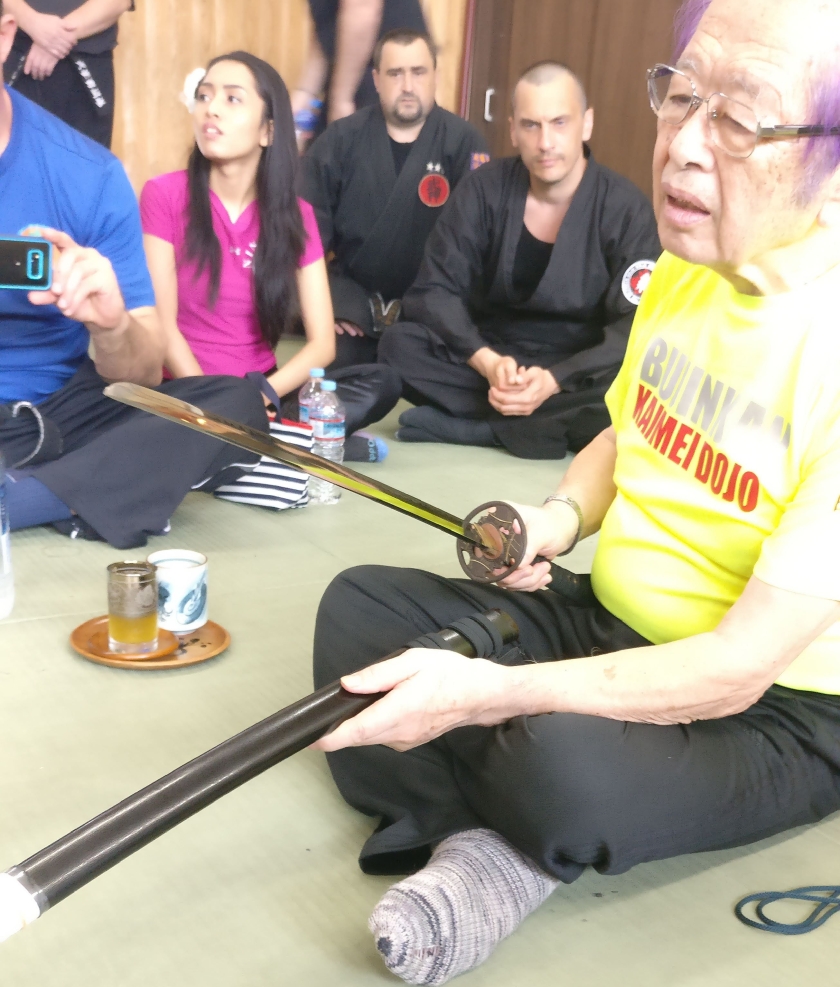
During the break, Sensei displayed a new katana. But unsheathing it, inside was a ninjatō. He told us that he was collecting a hundred of these ninjatō to make an exhibition. He said that he wanted to show the world of scholars how wrong they were. Truth is not in the books, it is in real life. A theory doesn’t supersede praxis. He then spoke about history.
“In history,” he said, “the names of the important players are often hidden. They are not forgotten. The ones we learn about in our textbooks, are there to help us not to forget, but they are not always the major ones. Important actions in life are being conveyed in the shadows”.
What you don’t see is superior to what you can. This is what differentiates the Omote from the Ura, exactly like in a technique. When Sensei moves, the things you see are not always what makes it possible. It is the invisible, the Kūkan, that gives life to the movements.
At the beginning of the class, Sensei spoke again about “controlling the space” with Mutō Dori. He said that we “do not have to control the space, but to control within the space.”
When you only control the space there are not so many options, you wrap the situation. But when your control applies “within the space,” you can create many actions. In an instant, you act on it, or not. Doing nothing is always a possibility. You are free in your body and your mind, everything is open, you are at the Ura level.
This is not the case with Uke. As he sees (or feels) what you can do, his mind is being trapped in an endless analytical process. The vast number of your possible reactions overwhelms him. His decision process is stuck at the Omote level. As a consequence, he can only react, too late, to what you are doing. When your control applies “within the space,” you are at the master of the game.
Whatever Uke tries to do, based on the Omote analysis of your actions, is visible to you. As you have no preconceived idea, your awareness is total. You see Uke’s reactions like waves you can surf when they unfold before your eyes.
During the class, Tezuka san launched a Tsuki with a knife to Sensei. Sensei stopped him with one finger to support him. He seemed like suspended in mid-air as if Sensei was “not there.” Sensei was not emitting anything.
Waiting for Sensei’s next move, he couldn’t carry out his attack to the end. Instead, he stood there frozen in time and space. When Sensei stopped supporting him, Tezuka san fell straight to the ground. It was like watching a Roadrunner cartoon. The coyote stays suspended in the air before dropping down from the cliff.
Tezuka san explained that he got locked there because he was unable to know or feel what Sensei was going to do next. And at the exact moment he made a decision to move, sensei “disappeared” and gravity took over.
In the dōjō as in our lives, we have to use the Ura more than the Omote. Remember that what you show is less valuable than what you are.